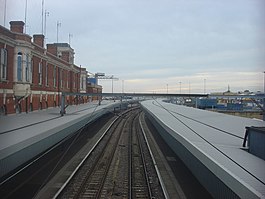Harwich International railway station
| Harwich International |
|
|---|---|
 |
|
| Location | |
| Place | Parkeston |
| Local authority | Tendring |
| Coordinates | 51°56′49″N 1°15′18″E / 51.947°N 1.255°ECoordinates: 51°56′49″N 1°15′18″E / 51.947°N 1.255°E |
| Grid reference | TM238326 |
| Operations | |
| Station code | HPQ |
| Managed by | Abellio Greater Anglia |
| Number of platforms | 3 |
| DfT category | E |
| Live arrivals/departures, station information and onward connections from National Rail Enquiries |
|
| Annual rail passenger usage* | |
| 2011/12 |
|
| 2012/13 |
|
| 2013/14 |
|
| 2014/15 |
|
| 2015/16 |
|
| History | |
| 1883 | Opened as Harwich Parkeston Quay |
| 1995 | Renamed Harwich International |
| National Rail – UK railway stations | |
| * Annual estimated passenger usage based on sales of tickets in stated financial year(s) which end or originate at Harwich International from Office of Rail and Road statistics. Methodology may vary year on year. | |
|
|
|
Harwich International railway station is on the Mayflower Line, a branch of the Great Eastern Main Line, in the East of England, serving Harwich International Port and the Parkeston area of Essex. It is 68 miles 72 chains (110.9 km) down-line from London Liverpool Street and is situated between Wrabness to the west and Dovercourt to the east. Its three-letter station code is HPQ, which derives from its original name, Harwich Parkeston Quay.
The station is currently operated by Abellio Greater Anglia, which also runs all trains serving the station. It is the eastern terminus in England of the Dutchflyer service between London and Amsterdam.
The station has two entrances. One is located on the ground floor of the passenger terminal building which houses a staffed ticket office and ticket machines, and provides direct access to platform 1 and indirect access to platforms 2 and 3 via a footbridge. The second entrance is from a car-park via the footbridge, although this entrance is unstaffed and has no ticketing facilities. The platforms can also be accessed via a level crossing at the eastern end of the platforms.
Generally platform 1 is used as the terminus of Dutchflyer trains towards London. Platform 2 is bi-directional and is served by local Mayflower Line services between Manningtree and Harwich Town, while platform 3 is used by services for Lowestoft, Norwich and Cambridge.
...
Wikipedia
